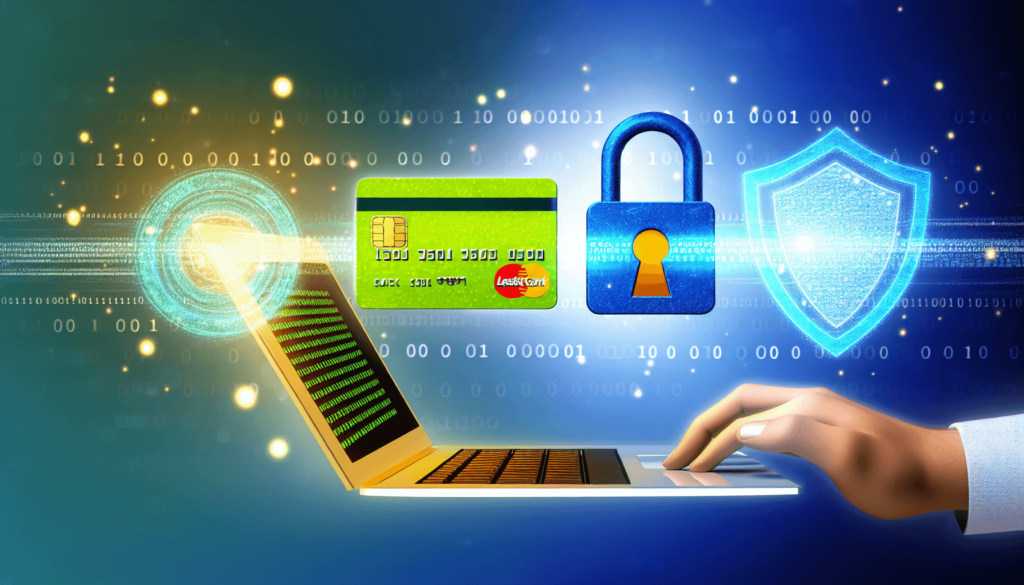Unlock the potential of your credit card use without falling into debt. Managing your card smartly means knowing how to maximize benefits like rewards while keeping costs down. In this practical guide, we’ll show you the essential tactics for smart credit card use, explaining key features and smart habits to ensure your plastic works harder for you.
Key Takeaways For Smart Credit Card Use
- Understanding the basics of credit cards is essential, including terms like credit limits, interest rates, and billing cycles. Credit utilization should be below 30% to avoid negatively impacting your credit score.
- Responsible credit card use involves strategic budgeting, prioritizing debt repayment, and maximizing rewards through careful selection of rewards programs that align with personal spending habits.
- Protecting your credit card information and navigating credit card fees, such as annual fees, balance transfer fees, and foreign transaction fees, are crucial for secure and cost-effective credit card use.
Understanding Credit Card Basics

Grasping the basics is the initial step towards smart credit card use, including understanding the difference between a regular credit card and a secured credit card. A credit card is essentially a form of short-term borrowing that allows you to make purchases, pay bills, or withdraw cash. Unlike a debit card, which directly withdraws funds from your bank account, a credit card extends a line of credit, often referred to as your credit limit, which you are expected to repay.
You need to get acquainted with key features like:
- Credit limits
- Interest rates
- Billing cycles
- Grace periods
to comprehend your credit card account. These components play a significant role in your credit history and credit scores and can influence your financial health when not managed responsibly.
Credit Limit
One of the fundamental aspects of credit card basics is the credit limit. The credit limit is the maximum amount you can charge to a card. Your credit limit is determined by your credit card issuer based on factors such as:
- your credit report
- credit score
- income
- other financial considerations
Bear in mind that maximizing your available credit can detrimentally affect your credit score. The Consumer Financial Protection Bureau (CFPB) recommends keeping your credit utilization ratio (the percentage of your total available credit that you’re using) under 30%. So, even if you haven’t maxed out your card, high utilization can be a red flag to potential lenders that you’re overextended and may have trouble paying bills.
Interest Rates and APR
You need to comprehend how interest rates and the annual percentage rate (APR) affect your credit card balance as a cardholder. The APR represents the cost of borrowing on your credit card, which includes both the interest rate and any additional fees.
Interest on a credit card is the charge for borrowing funds, which accrues if the full balance is not repaid by the end of the billing cycle. Changes in the federal funds rate set by the Federal Reserve often lead to adjustments in credit card APRs, as banks react by altering their prime rates. Therefore, monitoring these changes and understanding how they impact your credit card APR is crucial for managing your debt.
Billing Cycle and Grace Period
Along with understanding credit limits and interest rates, grasping the notions of billing cycles and grace periods is also critical. A credit card billing cycle typically ranges from 28 to 31 days, and the statement balance is based on:
- purchases
- balance transfers
- cash advances
- interest charges
- fees
- payments
- credits from that period.
The grace period allows for no interest on purchases, usually lasting 21 to 25 days from the statement closing date. To benefit, pay the full balance by the due date. If not, interest accrues on new purchases, and the grace period could be lost. Understanding billing cycles and grace periods helps avoid interest and manage purchases. However, carrying balances can impact the credit utilization ratio negatively.
Responsible Credit Card Use Strategies

Having discussed the fundamentals of credit cards, we can now explore strategies for using a credit card responsibly. Being a responsible credit card user involves more than just making payments on time. It also means:
- Understanding your financial situation
- Setting a budget and sticking to it
- Paying bills on time
- Spending within your means
- Fully paying off the balance each month to avoid debt
Maximizing credit card benefits is another part of responsible credit card use. Here are some tips to help you make the most of your credit card benefits:
- Use the card for everyday purchases to earn rewards or cash-back offers.
- Pay the balance in full each month to prevent accruing interest charges.
- Regularly check credit card statements to keep track of expenses and spot any fraudulent transactions.
By following these tips, you can effectively manage your finances and take advantage of the benefits offered by your credit card.
Budgeting and Tracking Expenses
Creating a budget is key to wise credit card use. A good budget covers necessary expenses and minimum debt payments first. Then, it allocates extra funds to reducing debt. Actively monitor spending by reviewing purchases online and using annual spending reports from issuers.
Use account alerts and ‘card lock’ features to prevent impulsive purchases and stick to your budget. Remember, a higher credit limit means more buying power, but it’s vital to stay disciplined to avoid debt.
Prioritizing Debt Repayment
Alongside budgeting, assigning priority to debt repayment is of equal importance. There are multiple strategies to tackle this, such as the avalanche and snowball methods.
The avalanche method focuses on paying off debts with the highest interest rates first. This approach saves on total interest and speeds up repayment. On the other hand, the snowball method prioritizes clearing the smallest debts first. This builds a sense of achievement and motivation, even though it might lead to more interest paid if larger debts have higher rates.
Whichever method you choose, the key is to remain consistent and committed to your debt reduction plan.
Utilizing Credit Card Rewards Wisely
Responsible use of credit cards presents a substantial advantage in the form of credit card rewards. However, they should be utilized wisely to maximize benefits without negatively impacting credit scores. Choosing a rewards card that aligns with personal spending habits, such as a travel card for travel enthusiasts or a card offering cash-back on groceries and gas for families, is crucial for maximizing rewards.
Using specific cards for specific purposes and paying off balances promptly can increase rewards benefits without negatively impacting credit scores. When comparing credit cards, frequent travelers should consider co-branded airline or hotel credit cards with annual fees if the perks, like travel-related rewards, equal or exceed the cost of the card. Additionally, line credit cards can be a suitable option for those seeking flexible spending limits.
Building and Maintaining Good Credit

Establishing and sustaining a good credit score is fundamental to financial health. A good credit score offers a variety of benefits, including lower interest rates on loans and credit cards, better terms on loan products, and increased chances of rental and job applications’ approval. Your credit score is made up of several factors, including your payment history, credit utilization, the mix of credit types, the length of your credit history, and recent credit applications.
On-time payments constitute 35% of a FICO score, making them the most important aspect of credit score maintenance. Keeping credit card balances low is also crucial as credit utilization counts as the second largest factor in credit scoring, recommending a utilization ratio under 30%. Let’s delve deeper into these factors.
On-Time Payments
For the upkeep of a robust credit score, punctual payments are pivotal. Late payments can have serious negative impacts on your credit score and can result in late fees and increased interest charges.
Timely credit card payments can be ensured by setting up autopay, electronic reminders, and by simplifying payment due dates to have every card on the same schedule. Using autopay for recurring bills guarantees payments are always on time; for optimal credit score impact, dedicate one card for autopay expenses and keep it secure and not carried around.
Managing Credit Utilization Ratio
Another key element in upholding good credit is the management of your credit utilization ratio. This ratio is defined as the percentage of available credit in use and should ideally be kept below 30% to maintain a healthy credit score.
Several strategies can be employed to manage your credit utilization ratio. These include:
- Requesting a credit limit increase
- Paying down balances before the billing cycle ends
- Using multiple cards for large purchases to distribute the balance
- Keeping old accounts open to preserve total available credit
Remember, a high credit utilization ratio can negatively impact credit scores, and this applies to both the overall credit utilization across all cards and individual card utilization rates.
Diversifying Credit Mix
Showing responsible credit management can also be done by diversifying your credit mix. This includes having a diverse mix of credit types, such as:
- Installment loans
- Mortgages
- Auto loans
- Credit cards
Revolving accounts like credit cards demonstrate the ability to handle variable borrowing and repayment, while installment accounts like loans show reliability in making fixed payments; both influence credit scores. It’s important to avoid opening multiple credit accounts rapidly as it can lead to hard inquiries, potentially harming the credit score temporarily.
Safeguarding Your Credit Card Information

Safeguarding your credit card information holds as much importance as knowing its use. This involves proactive measures such as monitoring account activity, reporting lost or stolen cards, and protecting personal information. These steps not only protect your financial resources but also safeguard your credit score and personal reputation.
Using digital wallets like Apple Pay or Google Pay, not saving credit card information on online retailers’ websites, being cautious of unexpected requests for financial information, and recognizing the tactics of phishing scams are some of the measures to promptly address potential threats and protect your credit card information.
Monitoring Account Activity
Keeping a regular check on your account activity is a vital part of protecting your credit card information. By signing up for alerts from your financial institutions, you can be notified of transactions on your accounts.
Reviewing your credit card statements allows you to confirm each charge and report any inaccuracies, such as incorrect fees or billing amounts. Regular monitoring of financial accounts is crucial for the early detection of unauthorized or fraudulent purchases.
Reporting Lost or Stolen Cards
In case of loss or theft of your card, it is imperative to instantly notify the issuer to halt the account and stop further transactions. Many credit card issuers offer options to lock or freeze your card through your account if it’s suspected lost or stolen, temporarily blocking new purchases and protecting against unauthorized use.
Understanding that you may be held liable for up to $50 in fraudulent transactions if your card is stolen and you report the charges after they occur, it’s crucial to report a lost card as soon as possible. After reporting a lost card, diligently monitor your credit card statements to identify and report any fraudulent transactions that may appear.
Protecting Personal Information
Securing your personal information is an essential measure in protecting your credit card data. Simple steps like:
- using strong, unique passwords for each account
- enabling two-factor authentication
- regularly monitoring your credit card statements for any suspicious activity
can reduce the risk of unauthorized access.
Being vigilant about phishing and spoofing scams by verifying contact authenticity and not providing sensitive information in response to unsolicited requests can also help protect your information. To safeguard personal information on public Wi-Fi networks, consider using a virtual private network (VPN) to create a secure, encrypted connection that shields data from potential interceptors.
Navigating Credit Card Fees

Understanding credit card fees also forms a part of intelligent credit card usage. Understanding various types of fees, like annual fees, balance transfer fees, and foreign transaction fees, can help you make informed decisions and avoid unexpected costs.
Whether it’s understanding when annual fees apply, how balance transfer fees are charged, or what kind of foreign transaction fees might apply when you’re traveling, a clear comprehension of these fees can save you money and avoid unnecessary surprises.
Annual Fees
Many credit cards, particularly those providing significant rewards or benefits, routinely charge annual fees. These fees can range from $25 to several hundred dollars, depending on the type of card. While these fees can seem off-putting, they can be justified if the rewards and benefits offered by the card outweigh the cost.
Some issuers may waive the annual fee as part of a promotion or for cardholders who meet certain spending thresholds each year. Therefore, it’s important to weigh the benefits against the cost of the annual fee when choosing a credit card.
Balance Transfer Fees
Credit card users frequently come across another type of fee known as balance transfer fees. These fees are generally a percentage of the amount transferred to a new credit card and can add substantial cost to the debt.
However, some credit card promotions offer 0% APR on balance transfers with no balance transfer fee for a limited time. This can be a valuable option for those looking to consolidate debt and save on interest charges.
Foreign Transaction Fees
For regular international travellers, foreign transaction fees form another potential cost. These fees are typically charged at 1% to 3% of the transaction amount and apply to purchases made abroad.
To avoid these additional costs, consider:
- Using credit or debit cards that do not charge foreign transaction fees for purchases or cash withdrawals while traveling internationally
- Opting to be charged in the local currency
- Using a card with no foreign transaction fees for international transactions
These steps can minimize these additional costs.
Summary
In conclusion, smart credit card use involves understanding credit card basics, practicing responsible credit card use strategies, building and maintaining good credit, safeguarding your credit card information, and navigating credit card fees. By following these strategies, you can maximize the benefits of your credit card, minimize debt, and maintain a healthy credit score. Remember, credit cards are not just a way to spend money; they’re a powerful financial tool that, when used wisely, can offer significant benefits and peace of mind.
Frequently Asked Questions
The actual use of a credit card is to provide a cash-equivalent payment tool, allowing you to buy now and pay later. It also offers benefits such as a grace period for payments and the opportunity to build credit.
The advantage of using a credit card includes building credit, earning cash back, and benefiting from fraud protection. These are just a few of the many benefits you can enjoy.
Aim to keep your credit utilization ratio below 30% to ensure a healthy credit score. This ratio is the percentage of available credit that you are currently using.
To ensure timely credit card payments, you can set up autopay, use electronic reminders, and simplify payment due dates to have all your cards on the same schedule. This will help you manage your payments effectively.
To safeguard your credit card information, monitor account activity, report lost or stolen cards promptly, and protect personal information by using strong passwords and being vigilant about phishing and spoofing scams. These steps will help keep your credit card information secure.




